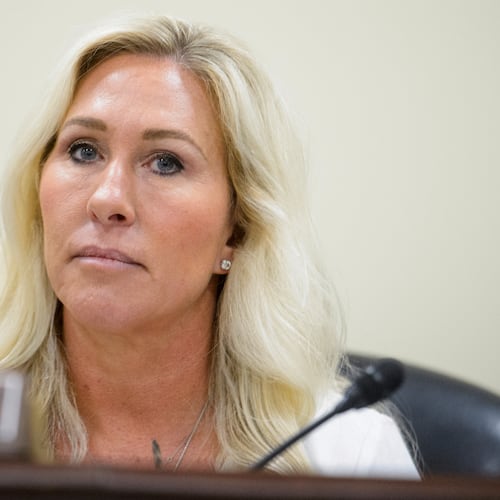Georgia’s plan to let a private company control tolls on I-285 promises rewards and risks for metro Atlanta commuters.
State officials this week said they will seek substantial private investment in the $6.1 billion effort to build toll lanes on the top half of the Perimeter. To recoup its investment, the selected firm would set toll rates and keep the revenue for 50 years.
The Georgia Department of Transportation says private money will allow it to build more toll lanes and more entry points to those lanes than currently planned. That could mean more traffic relief, even for motorists in the free lanes. If it’s done properly, supporters say the public has little to lose and much to gain from private investment in one of the busiest stretches of highway in the nation.
“If it’s going to give us more (road) project for a lesser amount of public funding, that’s a good thing,” said Chris Tomlinson, executive director of the State Road and Tollway Authority.
Skeptics aren’t so sure a company seeking private gain will prioritize the public good. They say commuters might face higher tolls because a private firm must charge enough to earn a profit. And they worry that putting the highway in private hands for decades could hinder the development of bus rapid transit or other future traffic solutions at a time when transportation technology is rapidly changing.
“Are we going to sign a contract for 50 years and we don’t know what we don’t know?” said Brian Gist, a transportation attorney at the Southern Environmental Law Center. “Once the contract is signed, that’s the deal. If it hurts their bottom line, the private partner has no incentive to do those things.”
The cost of a bad deal would be high.
Some 260,000 vehicles a day pass through the busiest stretches of the Perimeter, a number that is expected to grow as metro Atlanta adds a projected 2.9 million more residents by 2050. Traffic already bogs down for hours during morning and afternoon commutes. It could get worse in the decades ahead.
GDOT’s solution: adding “managed” toll lanes along nearly 40 miles of the top half of the Perimeter, from I-20 west of Atlanta to I-20 on the east.
Like metro Atlanta’s existing toll lanes, the price for using the Perimeter lanes would rise and fall with traffic congestion. The worse the traffic, the higher the toll. The idea is to raise the price to discourage enough motorists from using the lanes to keep traffic moving at an average of 45 mph.
That keeps traffic moving for those willing to pay by the mile. But GDOT says the toll lanes also help those in the “free” lanes because every car in the toll lanes is one that’s not taking up space in the free lanes.
Already GDOT has built about 67 miles of a planned 120-mile network of metro Atlanta toll lanes. The proposed I-285 lanes are crucial to that network — serving as the wheel to the spokes on I-75 and I-575 northwest of Atlanta, I-85 to the northeast and eventually on Ga. 400.
Initially, GDOT planned to build two toll lanes in each direction along the top end of the Perimeter — roughly between I-75 and I-85 — plus a single lane in each direction on the east and west sides. But the prospect of private investment has changed those plans.
GDOT Commissioner Russell McMurry said private investment would allow construction of two lanes in each direction on the east and west sides, instead of one. It might also allow for more entry points than GDOT currently envisions, including possible connections at I-20 on the east and west sides and at Stone Mountain Highway.
In exchange for such investments, the selected firm would set the tolls and keep the revenue for 50 years. Many details — including which firm will be selected, how much it will invest and any limits on its tolling authority — have not been determined.
GDOT has used public-private partnerships to help design, build and finance other projects, including the I-285/Ga. 400 interchange and the upcoming Ga. 400 toll lanes. But those projects did not involve allowing private firms to collect tolls.
Other states have used such arrangements.
A new report by the libertarian Reason Foundation cites nearly 20 road and bridge projects financed through substantial private investment in return for tolling revenue. They include the North Tarrant Expressway in Fort Worth, Texas, I-66 in northern Virginia and I-77 near Charlotte, North Carolina. The approach also has been used more widely in countries such as Australia, France, Italy and Spain.
Robert Poole, the Reason Foundation’s director of transportation policy, supports such public-private partnerships. But he said Georgia’s contention that it can’t build the additional lanes or entry points on I-285 without private investment is “a little hype, I think.” He said the state could probably expand the scope of the project without private investment.
In a statement, GDOT said that while it could “theoretically commit additional funding to the project, it would necessarily come at the expense of other high-priority programs and projects around the state, and that is not a viable option.”
“Additionally, while many states heavily leverage this revenue stream, it comes at a cost,” the statement said. “The state of Georgia is very prudent in the use of public bonding due to the negative effects to the state’s credit rating — which at AAA helps the state maintain its standing as one of the best states in the country to do business.”
Poole said the chief benefit of private investment is to shift the financial risks — including cost overruns, construction delays and lower-than-expected revenue — to the private sector. On a “mega project” such as the Perimeter express lanes, he said those risks are substantial.
“The hope (for investors) is it will be a profitable venture,” Poole said. “A hope is not a guarantee.”
Indeed, some companies that invested in toll projects such as the South Bay Expressway in San Diego, Texas’ SH 130 and Virginia’s Pocahontas Parkway filed for bankruptcy or otherwise failed. But Poole said taxpayers have not been on the financial hook for those failures, and commuters weren’t affected.
“I have yet to hear of a road or highway that wasn’t still available to motorists who used it and relied on it every day,” said Tomlinson, the Georgia tollway director. “I can’t imagine a situation where a part of 285 isn’t available.”
Skeptics say commuters could be affected in other ways, including higher tolls.
“There’s no free money here. Georgians will pay for this one way or another,” said Gist, the Southern Environmental Law Center attorney. “By bringing in private partners, they’ll pay for the project and pay for the private partner to make money.”
He also worries that higher tolls will price poor people out of the lanes. Research shows that people of all incomes use toll lanes, though wealthier people use them more frequently.
Gist isn’t the only one asking questions. At a Wednesday meeting, State Transportation Board member Kevin Abel asked for a full accounting of the risks of the plan.
Abel wants the contract to require the development of bus rapid transit in the lanes, as envisioned by MARTA and local officials along the top end of the Perimeter. He also wants GDOT to get some of the financial gains from tolls beyond a certain return on investment for the company.
Another concern: contract provisions that could require Georgia to compensate the company for making other transportation improvements that affect toll revenue. For example, if the state improved a nearby road, it could encourage motorists to get off I-285. Fewer motorists could mean less revenue for the company.
A decade ago the state scrapped plans to let a private company collect tolls on the I-75 and I-575 lanes in Cobb and Cherokee counties, in part because a proposed contract included such a provision. State officials worried it could prohibit GDOT from improving nearby roads.
Abel said he wants to “minimize” such provisions in a contract governing the I-285 lanes.
Such details must be negotiated with the firm and aren’t likely to be nailed down any time soon.
Poole said those negotiations will be key to a successful project. He said other states have required companies to set aside revenue for transit and to set toll policies that maximize efficient traffic movement, rather than profit.
McMurry said transit, tolling and other concerns will be addressed in the contract. And he said the state would not lose control of the highway.
“It’s truly a partnership that has to be exercised to get it right,” he said. “It’s not that we turn it over and never see it again. It takes ongoing management.”
Despite the many uncertainties, the plan has important backers, including Gov. Brian Kemp. In a statement issued late Wednesday, Kemp said he supports “GDOT and SRTA as they continue to explore this cutting-edge approach to the I-285 express lanes.”
GDOT expects to announce information about public hearings on its plan by the end of the year.
What it means for commuters
The Georgia Department of Transportation will seek private investment in toll lanes on the top half of I-285 in metro Atlanta. The selected company would recoup its investment by setting toll rates and collecting the revenue for 50 years. Here’s what it could mean for commuters:
More lanes: GDOT says private investment means more new toll lanes than the state alone can pay for. The agency says that means more traffic relief, even for motorists who don’t use the toll lanes.
More entry points: The agency says private investment may pay for more entry points to the toll lanes than GDOT currently envisions, allowing more people to easily access the lanes.
Safer lanes: GDOT’s current plans call only for a painted “buffer” separating the new toll lanes from the free lanes on the east and west side of the Perimeter. The agency says private investment would allow installation of concrete barriers to separate the toll lanes from general traffic, creating safer travel.
Higher tolls: The benefits come with a potential catch: Unlike the public agency that sets tolls on existing express lanes, a private company must charge enough to make a profit. That could mean higher tolls than a public agency would charge.
About the Author
Keep Reading
The Latest
Featured



